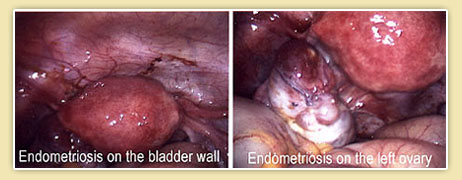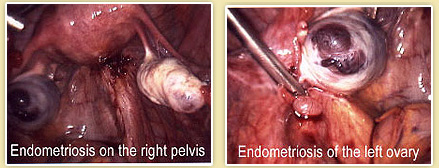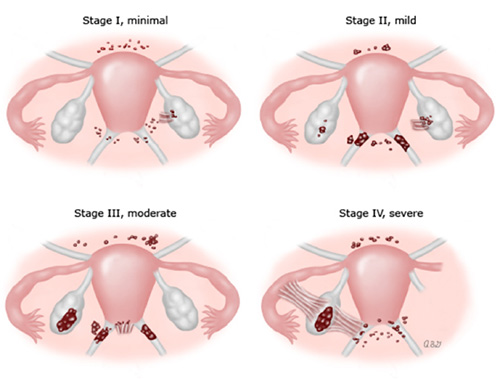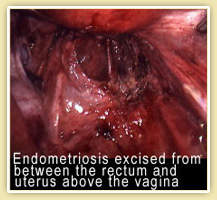Excision of Endometriosis
How to find the “RIGHT” laparoscopic endometriosis surgeon
There are TWO types of endometriosis surgeons
- The first type of surgeon just “FULGURATES” (aka burns) the endometriosis implants. I do NOT believe that the fulguration of endometriosis implants is an effective long-term treatment. Endometriosis implants are like SPLINTERS or thorns in your pelvis. Just “burning” the splinter does NOT solve the problem of pelvic pain. Each endometriosis implant (aka splinter) needs to be excised and removed.
- The second type of surgeon “EXCISES” the endometriosis implants. I believe the EXCISION of endometriosis implants is the BEST treatment option. For example, if there are 10 or more endometriosis implants in the pelvis, then each individual implant needs to be excised completely. The main limitation for excision surgery is for patients with severe Stage IV endometriosis, which is like taking a bucket of paint and throwing the paint on a white wall. For Stage IV endometriosis, it is impossible to remove all the endometriosis implants

What is Endometriosis
Endometriosis is a condition in which the lining of the uterine cavity (endometrium) grows outside of the uterus. Endometriosis can be found anywhere in the pelvic cavity, including all the reproductive organs such as the uterus, in addition to the bladder, bowel, and appendix.

The most common sites of endometriosis inside the pelvis are found on the uterosacral ligaments, posterior cul-de-sac, pelvic side walls, and ovaries. In rare occasions, endometriosis has been found on surgical scars sites like the C-section site or the prior abdominal laparotomy site, as well as inside the bladder, lung, spine, and brain. Although endometriosis differs somewhat from the normal lining of the uterine cavity, endometriosis responds to a woman's hormones each month. As a result, the endometrial lesions can be inflamed and can bleed into the surrounding tissues. This cycle of inflammation and bleeding can lead to scar tissue formation inside the pelvis and cause worsening pelvic pain.
What causes Endometriosis?
The real cause of endometriosis remains unknown. There are many theories that try to explain the etiology of endometriosis, but none of them can explain all cases of endometriosis. We do know, however, that endometriosis is not caused by anything that the patient has done. The most common explanation is RETROGRADE MENSTRUATION.
Retrograde Menstruation
This idea was proposed by Dr. John Sampson of Boston in the 1920’s. Normal menstrual blood flows from inside the uterine cavity to the OUTSIDE of the body. Sampson believed that endometriosis occurs when the menstrual blood flows BACKWARDS from the uterine cavity and refluxes through the fallopian tubes into the pelvis and the surrounding organs.
However, 90% of women have retrograde menstrual flow but only 15% of women develop endometriosis. The scientific literature, as well as our own experience, has shown that the actual rate of persistent or recurrent disease is surprisingly low after aggressive conservative surgical excision at laparoscopy or laparotomy, and the rate of recurrent or persistent disease does not appear to increase with the passage of time following excision surgery.
FOUR Stages of Endometriosis, ranging from Stage I – Stage IV

Symptoms of Endometriosis
Patients with endometriosis can have symptoms varying from constant excruciating pelvic pain to no symptoms whatsoever. Paradoxically, the extent of endometriosis has no correlation to the amount of pain a woman will experience. Some women with severe endometriosis do not have any symptoms and may not know they have endometriosis until a pelvic mass is detected on a routine pelvic examination or a problem with infertility is discovered. The following are the common symptoms of endometriosis, but remember that women with endometriosis may have all, some, or none of these symptoms.
- Pain and Discomfort in the Pelvic Area. Women with endometriosis most commonly experience increasing pain and discomfort right before and during their monthly cycles. Painful sexual intercourse, pressure and bloating in the lower abdomen and severe, sometimes incapacitating, cramps during this period are not uncommon. Some women with endometriosis, however, have constant pelvic pain and cramps which may not be associated with monthly cycles.
- Abnormal Uterine Bleeding. A woman with endometriosis may have some vaginal spotting a few days before and/or after her period, or she may have abnormally heavy and long periods.
- Gastrointestinal Symptoms. Gastrointestinal dysfunction ranges from abdominal bloating or nausea to intestinal cramps, cycles of diarrhea and/or constipation. Rectal bleeding and painful bowel movements may occur when the rectum and sigmoid colon are invaded by the endometriosis.
- Infertility. The most common cause of unexplained female infertility is endometriosis.
- Urinary symptoms. Frequency, urgency, bladder pain, and occasionally bloody urine may occur when endometriosis has involved the bladder. Endometriosis can invade the ureter (tube between the kidney and the bladder), may cause obstruction of the ureter, and damage the kidney.
- Lower back pain which may radiate down the legs.
Diagnosis of Endometriosis
Laboratory and imaging tests (ultrasound and x-rays) are not as helpful as the history and physical examination in diagnosing endometriosis. Surgical diagnosis via LAPAROSCOPY is the gold standard for the diagnosis of endometriosis. Laparoscopy (laparo = abdomen, scopy = inspection, thus, laparoscopy = inspection of abdominal cavity) helps visualize and stage the severity of endometriosis.
Treatment of Endometriosis
Currently there are ways to treat endometriosis. The first, second, and third line of treatment is hormonal therapy, most commonly birth control pills. The fourth line of treatment is Excision of Endometriosis surgery. Depending on the patient’s expectations and the extent of the disease, we may prescribe hormonal therapy followed by surgery. Often after surgery, I will recommend continued hormonal therapy to minimize the retrograde menstruation or re-seeding of the pelvis with endometriosis.
Hormonal Therapy
Hormonal therapy is based on the knowledge of the response of existing estrogen and progesterone receptors on ectopic endometrial tissue to certain hormonal agents. Since endometrial lesions are not all the same with regard to the number and response of receptors to the hormonal agents, the result of the hormonal treatment may vary from patient to patient. Hormonal therapy is considered as suppressive, thus temporary. Endometriosis will recur after the treatment is discontinued. Following are some of the currently available hormonal agents for treatment of endometriosis.
1. Birth Control Pills: Birth control pills, or oral contraceptives, are the combination of estrogen and progestin pills to regulate a patient’s hormonal levels and suppress endometrial growth. While a patient is on birth control pills, ovulation usually ceases, and endometrial lesions shrink. The common side effects of taking birth control pills are weight gain, nausea, headache, mood changes, depression, irregular vaginal bleeding, and loss of sexual desire.
2. GnRH Agonists: This agent works by suppressing the pituitary hormones (FSH and LH) to stop the ovary from producing estrogen, putting the patient into a menopausal state, and thus shrinking the endometrial lesions. The names of GnRH agonists include Orlissa, Lupron Depot, Synarel, and Zoladex. These drugs can be given by injection or nasal spray. The main side effects of menopausal syndromes are hot flashes, cold sweat, insomnia, vaginal dryness, loss of sexual interest, and depression. The FDA has approved GnRH agonists for no longer than six months in a lifetime due to the risk of osteoporosis.
3. Progestins: Progestins work by keeping the ovarian hormone (estrogen and progesterone) levels low to prevent ovulation and suppress endometrial growth. Common names of progestins are Provera, Cycrine, Megace, Micronor, Amen, Nor-Q.D., and Depo-Provera. The main side effects include irregular vaginal bleeding, depression, breast tenderness, moodiness, weight gain, headache, and fluid retention.
4. Danazol: Danazol exhibit some androgen (male hormone) effect and reduces ovarian hormonal production. Most women will stop ovulation and menstruation when they are on Danazol, and their endometrial lesions will shrink and become inactive. The main side effects of Danazol are weight gain, decrease in breast size, acne, oily skin, male-pattern hair growth, and deepening of the voice.
EXCISION Surgical Treatment

Laparoscopic EXCISION surgery is BEST option in the diagnosis and treatment of endometriosis. Ideally, all the endometrial lesions should be excised through the laparoscope at the initial diagnosis of endometriosis. Unfortunately, many gynecologists are not well trained in the laparoscopic excision treatment of severe endometriosis. Thus, many women with extensive endometriosis often require more than one surgery and suffer from many undesirable sequelae of poorly performed surgery. It is of utmost importance in finding a well-trained laparoscopic gynecologist at initial diagnosis and treatment of endometriosis.
The definite treatment of endometriosis is NOT hysterectomy and bilateral salpingo-oophorectomy (remove both uterus and ovaries) – Many gynecologists nowadays still mistakenly believe that remove both uterus and ovaries are the cure for endometriosis. In our center we believe strongly that the correct way of treating endometriosis is the complete excision of the endometrial lesions, whether it appears on the pelvic organs or ureter (tube that connects the kidney and the bladder), and bladder.
The decision of whether to perform hysterectomy or oophorectomy at time of endometriosis surgery will based on whether there is any coexisting uterine or ovarian pathology in addition to the presence of endometriosis and patient’s desire for future childbearing. For example, if patient is known to have severe endometriosis and no longer desires to bear a child, along with fibroids, then a hysterectomy plus excision of all endometriosis should be recommended for patient.